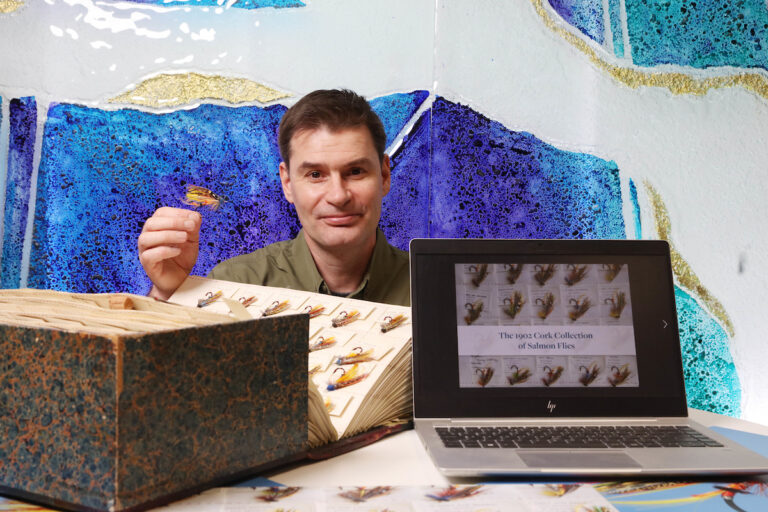Traditional Irish salmon flies from Dublin and across Ireland, commissioned one hundred and twenty years ago for the Cork International Exhibition in 1902, now feature in a new historical picture book from Inland Fisheries Ireland. Fly tying involves the ‘dressing’ of a fishing hook to create an artificial fly, which is then used by anglers at the end of a rod and line to catch fish. It’s a little-known part of Ireland’s heritage but many angling shops in Ireland in the late 1800s and early 1900s employed ‘fly dressers.’ Some were considered masters of their craft, thanks to their skills, creativity and the traditional methods that they used.
In recognition of the cultural importance of the craft and to record examples, a collection of traditional fly dressings was commissioned in 1902, with specific sets of flies collected for each of the twenty fishery districts throughout the country, including Dublin. The current custodians of this important collection, Inland Fisheries Ireland, has published the picture book online recently, making it freely available to new generations around the world.
For the 1902 Exhibition, the four salmon flies for the Dublin district were tied by J. Flint & Co., based on Essex Quay in Dublin city centre. The flies are now included in the new online book titled ‘The 1902 Cork Collection of Salmon Flies’. The salmon flies featured for the district include the ‘Jock Scott’ and the ‘Goldfinch’ and the recommended season for these flies was from March to May on the River Liffey from Islandbridge to Lucan Weir.
Shane O’Reilly of Inland Fisheries Ireland said: “This new book offers a unique glimpse into Ireland’s past, putting a spotlight on traditional salmon angling in Dublin and the other fishery districts of the era. Each of the flies showcases the detail and beauty of traditional Irish salmon flies and the wide range of materials and techniques used by Irish fly dressers at the time. Many of those fly dressers are now revered around the world for the quality of their craft, so this collection is of significant cultural importance too, and is now available for the next generation to discover.”
Over a hundred years after the Cork International Exhibition took place, interest in the collection was re-ignited by angling author, the late E.J. ‘Ted’ Malone, who described the collection as a “long lost treasure of Irish Angling”. Malone worked alongside Peter Kealey and Peter Dunne, all fly tying experts, to meticulously examine, photograph and record the various fly dressings. Sadly, Ted Malone passed away in 2017 and the book is dedicated to his memory.
Patterns and descriptions of over 380 individual flies can be found in the book, including those from the Dublin fishery district. Inland Fisheries Ireland is exploring ways of putting the original collection on display once more and members of the public are being encouraged to contact the state agency with any suggestions they may have‘ The 1902 Cork Collection of Salmon Flies,’ including the Dublin flies, is available to view from the Inland Fisheries Ireland website at www.fisheriesireland.ie and from the Fishing in Ireland website at www.fishinginireland.info


